I'm trying to use glBlendFunc in QOpenGLWidget (in paintGL), but objects do not mix (alpha is works).
My code:
glClear(GL_COLOR_BUFFER_BIT | GL_DEPTH_BUFFER_BIT);
glEnable(GL_DEPTH_TEST);
glEnable(GL_CULL_FACE);
glEnable(GL_BLEND);
glBlendFunc(blenFunc, GL_ONE);
m_world.setToIdentity();
m_world.rotate((m_xRot / 16.0f), 1, 0, 0);
m_world.rotate(m_yRot / 16.0f, 0, 1, 0);
m_world.rotate(m_zRot / 16.0f, 0, 0, 1);
QOpenGLVertexArrayObject::Binder vaoBinder(&m_vao);
m_program->bind();
m_tex->bind();
fillYoffsetLightning();
const GLfloat scaleFactor = 0.05f;
m_world.scale(scaleFactor, scaleFactor, 0.0f);
m_world.translate(0.f, 0.0f, 0.0f);
const GLfloat fact = 1 / scaleFactor;
const uint8_t X = 0, Y = 1;
for(int i = 0; i < maxElem; ++i) {
const GLfloat offX = m_ELECT[i][X] * fact;
const GLfloat offY = m_ELECT[i][Y] * fact;
m_world.translate(offX, offY);
m_program->setUniformValue(m_projMatrixLoc, m_proj);
m_program->setUniformValue(m_mvMatrixLoc, m_camera * m_world);
QMatrix3x3 normalMatrix = m_world.normalMatrix();
m_program->setUniformValue(m_normalMatrixLoc, normalMatrix);
glDrawArrays(GL_TRIANGLE_FAN, 0, m_logo.vertexCount());
update();
m_world.translate(-offX, -offY);
}
m_program->release();
shaders are simple:
// vertex
"attribute highp vec4 color;\n"
"varying highp vec4 colorVertex;\n"
//......... main:
"colorVertex = color;\n"
// fragment
"varying highp vec4 colorVertex;\n"
//......... main:
"gl_FragColor = colorVertex;\n"
Color is: a pentagon with a gradient from white from center to blue to the edges is drawn (center color is 1,1,1, edges is 0,0,0.5)
screenshoot

Why is this happening?